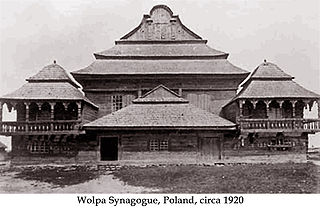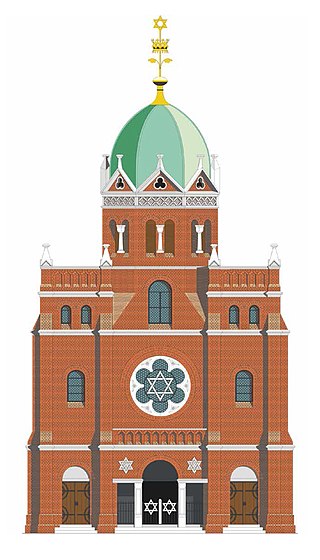
Rafał Aleksander Ziemkiewicz is a Polish political and science fiction author and right-wing publicist.

Gazeta Wyborcza is a Polish nationwide daily newspaper based in Warsaw, Poland. Launched on May 8, 1989, as the first Polish daily newspaper after the transformation. The newspaper was founded on the basis of the Polish Round Table Agreement, as a press organ of the trade union "Solidarity" in the election campaign before the Contract Sejm.

Yehuda Meir Shapiro, was a prominent Polish Hasidic rabbi and rosh yeshiva, also known as the Lubliner Rav. He is noted for his promotion of the Daf Yomi study program in 1923, and establishing the Chachmei Lublin Yeshiva in 1930.

Synagogue architecture often follows styles in vogue at the place and time of construction. There is no set blueprint for synagogues and the architectural shapes and interior designs of synagogues vary greatly. According to tradition, the Shekhinah or divine presence can be found wherever there is a minyan, a quorum, of ten. A synagogue always contains an Torah ark where the Torah scrolls are kept, called the aron qodesh by Ashkenazi Jews and the hekhal by Sephardic Jews.

The Remah Synagogue is a 16th-century Jewish temple and the smallest of all historic synagogues in the Kazimierz district of Kraków, Poland. The synagogue is named after Rabbi Moses Isserles (c.1525–1572), known by the Hebrew acronym ReMA who's famed for writing a collection of commentaries and additions that complement Rabbi Yosef Karo's Shulchan Aruch, with Ashkenazi traditions and customs. It is currently one of two active synagogues in the city.

The Great Synagogue, was a synagogue of the Jewish Community of Danzig in the city of Danzig, Germany. It was built in 1885–1887 on Reitbahnstraße, now Bogusławski Street. It was the largest synagogue in the city, and was demolished by the Free City authorities in May 1939.

Chachmei Lublin Yeshiva was a Jewish educational institution (yeshiva) that operated in the city of Lublin, Poland from 1930 to 1939. At the time, it was one of the largest in the world.

Kupa Synagogue is a 17th-century synagogue in Kraków, Poland. It is located in the former Jewish quarter of Kazimierz developed from a neighborhood earmarked in 1495 by King John I Albert for the Jewish community, which has been transferred from the budding Old Town. Kupa Synagogue serves Kraków's Jewish community as one of the venues for religious ceremonies and cultural festivals, notably the annual Jewish Culture Festival in Kraków.

The Włodawa Synagogue in Włodawa, Poland is an architectural complex consisting of two historic synagogues and a Jewish administrative building, now preserved as a museum. The complex includes the Włodawa Great Synagogue of 1764–74, the late 18th century Small Synagogue, and the 1928 community building. It is "one of the best-preserved" synagogues in Poland.

Wooden synagogues are an original style of vernacular synagogue architecture that emerged in the former Polish–Lithuanian Commonwealth. The style developed between the mid-16th and mid-17th centuries, a period of peace and prosperity for the Polish-Lithuanian Jewish community. While many were destroyed during the First and Second World Wars, there are some that survive today in Lithuania.

The Łańcut Synagogue is a Baroque synagogue in Łańcut, Poland. The Łańcut Synagogue is a rare surviving example of the vaulted synagogues with a bimah-tower, that were built throughout the Polish lands in masonry from the sixteenth through the early nineteenth centuries.

The Przedbórz Synagogue was a wooden synagogue in Przedbórz, Poland.

The Wołpa Synagogue was a synagogue located in the town of Voŭpa, in what is now western Belarus. It was reputed to be the "most beautiful" of the wooden synagogues of the former Polish–Lithuanian Commonwealth, a "masterwork" of wooden vernacular architecture.

The Tykocin Synagogue is a historic synagogue building in Tykocin, Poland. The synagogue, in mannerist-early Baroque style, was built in 1642.

The White Stork Synagogue is a nineteenth-century synagogue in Wrocław, Poland. Rededicated in 2010 after a decade-long renovation, it is the religious and cultural centre of the local Jewish community, under the auspices of the Union of Jewish Religious Communities in Poland. It is the only synagogue in Wrocław to have survived the Holocaust.

The Union of Jewish Religious Communities in Poland, is a religious association formed by Jews living in Poland who adhere to Judaism. It was originally created in 1949 as the Religious Association of Judaism, and renamed in 1992. The Association's seat is located in Warsaw, with seven administrative branches throughout the country. ZGWŻ consists of approximately 2,000 members (1998) congregating in nine municipalities. The Union operates seven active synagogues and 15 prayer houses. Also, ZGWŻ publishes its own periodicals, as well as the popular Jewish Calendar. Since 2003, the president of the Union is Piotr Kadlčik.
Lena Piękniewska is a Polish singer and actress.

The Synagogue of Kłodzko was located in Kłodzko, in Kłodzko County in Lower Silesia, Poland. The synagogue was built 1884–1885 on the Grünestraße, now Wojska Polskiego Street, but was destroyed in 1938 during the Nazi Kristallnacht anti-Jewish pogrom.

Chabad-Lubavitch of Poland is a synagogue located at 19/508 Słomińskiego Street in Warsaw. Another temple of this type in Poland is the Isaac Jakubowicz Synagogue in Kraków.

























